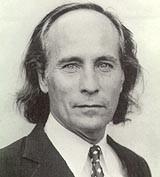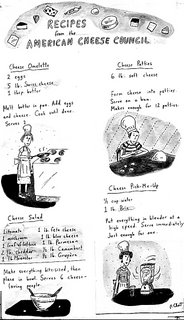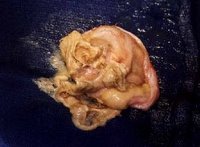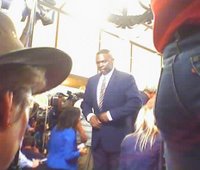duck and shoot
 Cut and Run. That’s the accusation Mr. POTUS consistently levels at his political opponents.
Cut and Run. That’s the accusation Mr. POTUS consistently levels at his political opponents.My opponents would Cut and Run. If we left Iraq now, that’d be Cutting and Running. We have to Stay the Course. We can’t Cut and Run.
Cut and Run. Where’d that come from? Cut. You can cut a fart. You can cut your nosehairs. You can cut carbs. And run? That seems pretty obvious. You can run, but you can’t hide. Your stockings can run. Your nose can run. But Cut and Run. What could that mean?
I’m lazy. Instead of pursuing the proper scholarly course to ferret out the phrase’s real etymology, I just type it into Google. In quotes. “Cut and Run.” I’ll be able to infer something from usage. Good god! 1,250,000 hits. I don’t have time for this.
 Perhaps my friend Geoff Nunberg has done this work for me; let's add him to the search string. Ah, 48 results. Much better. Here’s a post Geoff’s written in Language Log. Geoff is the one who explained Shrub’s ubiquitous use of the word “see” when he’s about to take a nuanced idea and turn it into something Sponge Bob Square Pants could understand. I'm disappointed that there's no Cut and Run, although I’m quite certain Geoff has weighed in about the phrase.
Perhaps my friend Geoff Nunberg has done this work for me; let's add him to the search string. Ah, 48 results. Much better. Here’s a post Geoff’s written in Language Log. Geoff is the one who explained Shrub’s ubiquitous use of the word “see” when he’s about to take a nuanced idea and turn it into something Sponge Bob Square Pants could understand. I'm disappointed that there's no Cut and Run, although I’m quite certain Geoff has weighed in about the phrase.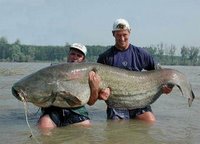 There’s some vague imagery in my mind of cutting a fishing line and letting the big one run away. But that can’t be right. How about consulting Word Detective?
There’s some vague imagery in my mind of cutting a fishing line and letting the big one run away. But that can’t be right. How about consulting Word Detective?Word Detective offers a very satisfying discussion of the origins of the phrase:
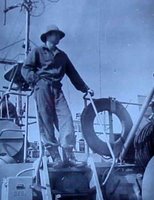 …The roots of "cut and run" actually lie in the days of sailing ships. A ship at anchor coming under sudden attack by the enemy, rather than waste valuable time in the laborious task of hoisting its anchor, would sacrifice the anchor by cutting the cable, allowing the ship to get under sail and escape the attack quickly. "To cut and run" was thus an accepted military tactic in emergencies, and the phrase itself dates to at least the early 1700s. By the mid-1800s, "cut and run" was in common use as a metaphor for abruptly giving up an endeavor in the face of difficulty, and appears in non-nautical context in Dickens's 1861 novel Great Expectations.
…The roots of "cut and run" actually lie in the days of sailing ships. A ship at anchor coming under sudden attack by the enemy, rather than waste valuable time in the laborious task of hoisting its anchor, would sacrifice the anchor by cutting the cable, allowing the ship to get under sail and escape the attack quickly. "To cut and run" was thus an accepted military tactic in emergencies, and the phrase itself dates to at least the early 1700s. By the mid-1800s, "cut and run" was in common use as a metaphor for abruptly giving up an endeavor in the face of difficulty, and appears in non-nautical context in Dickens's 1861 novel Great Expectations. Cut and Run. How pleasing to finally know what it means beyond being a pejorative term Shrub uses as a blanket substitute for any Middle East strategy proffered by a non-neocon. [Say “non-neocon” five times real fast. I bet you can’t. Even if you take those soda crackers out of your mouth, you can’t. Non-neocon. Non-neocon. Neo-noncon.]
Cut and Run. How pleasing to finally know what it means beyond being a pejorative term Shrub uses as a blanket substitute for any Middle East strategy proffered by a non-neocon. [Say “non-neocon” five times real fast. I bet you can’t. Even if you take those soda crackers out of your mouth, you can’t. Non-neocon. Non-neocon. Neo-noncon.]I am, however, slightly disappointed that Cut and Run didn’t have stronger ties to Cut and Shoot.
 When we lived in Texas, I remember a nearby Montgomery County town – a minor blip on the map – named “Cut and Shoot”. Cut ‘n Shoot, Texas. Like Cut and Run, Cut and Shoot has its roots in violence. According to The Online Handbook of Texas:
When we lived in Texas, I remember a nearby Montgomery County town – a minor blip on the map – named “Cut and Shoot”. Cut ‘n Shoot, Texas. Like Cut and Run, Cut and Shoot has its roots in violence. According to The Online Handbook of Texas:[Cut and Shoot] was apparently named after a 1912 community confrontation that almost led to violence. According to the different versions of the story, the dispute was either over the design of a new steeple for the town's only church, the issue of who should be allowed to preach there, or conflicting land claims among church members. A small boy at the scene reportedly declared, "I'm going to cut around the corner and shoot through the bushes in a minute!" The boy's phrase apparently remained in residents' minds and was eventually adopted as the town's name.
Aha! Cut and Shoot has a stronger relationship to Cut and Run than we would’ve thought. The phrase is tied to a religious war (witness the role of the town’s only church) and there’s a deep rift (conflicting land claims) leading to an outbreak of sectarian violence and – dare I say it – Civil War. (I’m of a mind to play fast and loose with chronology here. Everyone else does it. Why can’t I?)
In fact, this seems like an example of a larger, more exciting, phenomenon: if you take the time to examine the history of these small towns more thoroughly, you’ll no doubt find out more than you’d bargained for. Pittstown’s subnormal IQ (the IQ of the average Pittstownian hovers around 68, even on a good day) is a case in point. It is the result of a complex small-town history, complete with an economic base gone bad (stove manufacturing) and secret government experiments that took place in a former tuberculosis sanitarium, creepy experiments involving psychedelic drugs administered to retarded and mightily confused patients without their knowledge and no doubt against their will.
 Cut and Shoot – which apparently did not benefit from such an influx of government funds as our President’s favorite war – is not far from Chain of Lakes, Texas, the primary residence of a large alligator dubbed “The Major” by his fans. [I say “primary residence” because it’s well-known that he has a second home in Celebration, Florida, where he plans to retire. Nothing tastes better than a well-planned meal.]
Cut and Shoot – which apparently did not benefit from such an influx of government funds as our President’s favorite war – is not far from Chain of Lakes, Texas, the primary residence of a large alligator dubbed “The Major” by his fans. [I say “primary residence” because it’s well-known that he has a second home in Celebration, Florida, where he plans to retire. Nothing tastes better than a well-planned meal.]When I went out there in 1994, the Major had already been corrupted by many years of tourist-proffered marshmallows. These middle-westerners were so enchanted by the large reptile that they stopped themselves just shy of feeding him the juicier of their infant offspring. Which I’m sure he would’ve preferred. Probably better for his teeth and his overall health.
But they just loved to watch that big gator eat. Did those marshmallows lead him down the well-worn path to adult-onset diabetes?
He should’ve just Cut and Run.
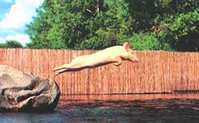 His life was probably a cut above the trials and tribulations of Ralph the Diving Pig, who hailed from Aquarena Springs, Texas (near San Marcos). The trouble with Ralph is that he gave the spectators a profound sense that he’d rather be Cutting and Running (or Cutting and Shooting) than diving. In fact, you got the feeling that he’d rather be doing just about anything else besides diving. Anything shy of becoming part and parcel of a sausage, that is, but that gives him a lot of wiggle room. He’d rather drive a Muni bus in San Francisco or wait tables in a Hooters in San Antonio. Anything but dive. Poor Ralph.
His life was probably a cut above the trials and tribulations of Ralph the Diving Pig, who hailed from Aquarena Springs, Texas (near San Marcos). The trouble with Ralph is that he gave the spectators a profound sense that he’d rather be Cutting and Running (or Cutting and Shooting) than diving. In fact, you got the feeling that he’d rather be doing just about anything else besides diving. Anything shy of becoming part and parcel of a sausage, that is, but that gives him a lot of wiggle room. He’d rather drive a Muni bus in San Francisco or wait tables in a Hooters in San Antonio. Anything but dive. Poor Ralph. According to some web sites, Ralph retired in the early 1990s. Between you and me, he surely did not retire. I know he was portrayed as leading the life of Riley, swimming with the glamorous mermaids whose rigid bouffants did not collapse even when subjected a dip in the Springs and drinking slop-tinis out of a special pig-friendly bottle. No, Ralphie would’ve rather Cut and Run, or perhaps relocated to Cut and Shoot (although there’s a certain risk that The Major would’ve gotten wind of such of a tantalizing feast or that Dick Cheney would’ve chosen the retreat as a tranquil place to hunt and spray his close friends and a stray diving pig with birdshot).
According to some web sites, Ralph retired in the early 1990s. Between you and me, he surely did not retire. I know he was portrayed as leading the life of Riley, swimming with the glamorous mermaids whose rigid bouffants did not collapse even when subjected a dip in the Springs and drinking slop-tinis out of a special pig-friendly bottle. No, Ralphie would’ve rather Cut and Run, or perhaps relocated to Cut and Shoot (although there’s a certain risk that The Major would’ve gotten wind of such of a tantalizing feast or that Dick Cheney would’ve chosen the retreat as a tranquil place to hunt and spray his close friends and a stray diving pig with birdshot). As long as we’re talking about fear-mongering, neo-cons, diving pigs, and military terminology appropriated by civilians, let’s take a gander at Duck and Cover.
As long as we’re talking about fear-mongering, neo-cons, diving pigs, and military terminology appropriated by civilians, let’s take a gander at Duck and Cover.It’s really beginning to feel like a barnyard here with the pigs and ducks and ganders and Dick Cheney’s hunting rifle. Dick Cheney’s hunting rifle?
Duck!
No. Duck and Cover.
Maybe you’re not old enough to remember Duck and Cover. Or maybe they’ve repurposed this exercise in surrealistic fear as an earthquake safety drill. But I remember it as the Drop Drill.
 The idea was that you’d hear Civil Defense sirens bleating in the background. You might’ve even heard the awe-inspiring roar of the detonated nuke. Your teacher’d shout “Drop!” And as fast as you could, you’d fold yourself under your desk, put your hands over the back of your neck, squeeze your eyes shut against the blinding light of the blast.
The idea was that you’d hear Civil Defense sirens bleating in the background. You might’ve even heard the awe-inspiring roar of the detonated nuke. Your teacher’d shout “Drop!” And as fast as you could, you’d fold yourself under your desk, put your hands over the back of your neck, squeeze your eyes shut against the blinding light of the blast.If you were a girl (and I was, even back then), you also pulled your pea coat off the back of your chair and threw it over your back because Ducking and Covering presented a substantial overexposure problem if you were wearing a miniskirt. It seemed to be more about Ducking and Uncovering. You certainly don’t want to meet your maker (or even spend your last atheistic moments on earth) with your butt exposed like that.
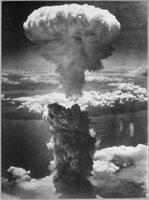 And – when the “all clear” had been sounded – you’d get back out from under your desk and form an orderly line. To march somewhere – somewhere unspecified, a destination that was less radioactive than your fifth grade classroom. Somewhere Mrs. Perkins would lead you. Single file and solemn, at arms-length from the kid in front of you. You’d march off into the nuclear sunset.
And – when the “all clear” had been sounded – you’d get back out from under your desk and form an orderly line. To march somewhere – somewhere unspecified, a destination that was less radioactive than your fifth grade classroom. Somewhere Mrs. Perkins would lead you. Single file and solemn, at arms-length from the kid in front of you. You’d march off into the nuclear sunset. I’m surprised that the current climate of fear has no attendant minor rituals like Duck and Cover. The teachers would time us. How fast could we dive under our desks? They’d use stopwatches to assess our Drop Drill performance. Talk about your educational metrics! We knew to the second how long it would take for a whole classroom full of fifth graders to dive under their desks. No child left behind.
I’m surprised that the current climate of fear has no attendant minor rituals like Duck and Cover. The teachers would time us. How fast could we dive under our desks? They’d use stopwatches to assess our Drop Drill performance. Talk about your educational metrics! We knew to the second how long it would take for a whole classroom full of fifth graders to dive under their desks. No child left behind.Surely Staying the Course should have some kind of physical enactment like this. Shouldn’t this be delegated to Karl Rove himself now that every other Republipol wants to distance him or herself from the man the President affectionately calls “Turd Blossom”? Karl Rove should be able to come up with an imaginative, appropriate, and potentially obscene counterpart to Duck and Cover.
He’d probably just suggest drafting the little bastards. Conscription. That’s what he’d do. What better way to enact fear than dress everybody up in uniforms and march ‘em somewhere.
 So we can’t trust these guys: we’ll have to do it ourselves. What’s the Duck and Cover drop drill that’ll allow us to Stay the Course? It’ll probably need to have a new name – X and Y – and, if there’s anything Google has taught us, it should have a sponsor: The Taco Bell Fourth Meal Nip and Tuck (this’ll probably involve an AK47, a dinghy, and cosmetic surgery). No – Nip and Tuck sounds wrong. How about the Axe Deodorant Body Spray Bob and Weave (this one’ll involve intricate maneuvers with a Glock, a condom, and a Peg Perego stroller).
So we can’t trust these guys: we’ll have to do it ourselves. What’s the Duck and Cover drop drill that’ll allow us to Stay the Course? It’ll probably need to have a new name – X and Y – and, if there’s anything Google has taught us, it should have a sponsor: The Taco Bell Fourth Meal Nip and Tuck (this’ll probably involve an AK47, a dinghy, and cosmetic surgery). No – Nip and Tuck sounds wrong. How about the Axe Deodorant Body Spray Bob and Weave (this one’ll involve intricate maneuvers with a Glock, a condom, and a Peg Perego stroller).Ah, I just don’t have it in me to create something as timeless as Duck and Cover. I’m just surprised that the pols don’t have this pinned down already. But what about you? Don’t you have some great ideas we can use here? And don’t exhort me to apply anything Directly to my Forehead. Let’s do some thinking here.
Oh, c’mon. Don’t be such a Drag (and Drop).







